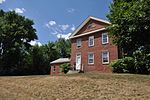Bissell Bridge (Connecticut)
Bridges completed in 1958Bridges in Hartford County, ConnecticutBridges on the Interstate Highway SystemBridges over the Connecticut RiverConnecticut building and structure stubs ... and 7 more
Connecticut transportation stubsFormer toll bridges in ConnecticutInterstate 91Northeastern United States bridge (structure) stubsNortheastern United States road stubsRoad bridges in ConnecticutWindsor, Connecticut

The Captain John Bissell Memorial Bridge carries I-291 over the Connecticut River, connecting the towns of Windsor, Connecticut and South Windsor, Connecticut. There is a pedestrian crossing on the bridge on the westbound, upstream side.
Excerpt from the Wikipedia article Bissell Bridge (Connecticut) (License: CC BY-SA 3.0, Authors, Images).Bissell Bridge (Connecticut)
Geographical coordinates (GPS) Address Nearby Places Show on map
Geographical coordinates (GPS)
| Latitude | Longitude |
|---|---|
| N 41.813055555556 ° | E -72.644444444444 ° |
Address
Sveinsstaðarétt
Island
Open on Google Maps










